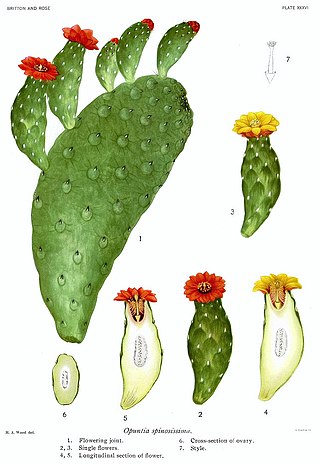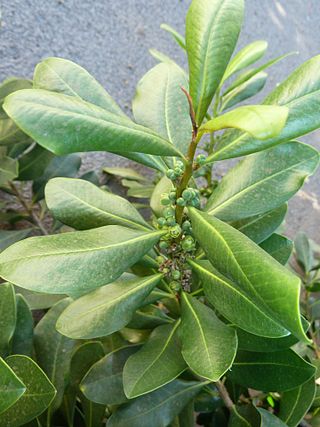Cypress is a common name for various coniferous trees or shrubs of northern temperate regions that belong to the family Cupressaceae. The word cypress is derived from Old French cipres, which was imported from Latin cypressus, the latinisation of the Greek κυπάρισσος (kyparissos). Cypress trees are a large classification of conifers, encompassing the trees and shrubs from the cypress family (Cupressaceae) and many others with the word “cypress” in their common name. Many cypress trees have needle-like, evergreen foliage and acorn-like seed cones.

The conservation status of a group of organisms indicates whether the group still exists and how likely the group is to become extinct in the near future. Many factors are taken into account when assessing conservation status: not simply the number of individuals remaining, but the overall increase or decrease in the population over time, breeding success rates, and known threats. Various systems of conservation status are in use at international, multi-country, national and local levels, as well as for consumer use such as sustainable seafood advisory lists and certification. The two international systems are by the International Union for Conservation of Nature IUCN and The Convention on International Trade in Endangered Species of Wild Fauna and Flora (CITES)

Juniperus excelsa, commonly called the Greek juniper, is a juniper found throughout the eastern Mediterranean, from northeastern Greece and southern Bulgaria across Turkey to Syria and Lebanon, Jordan, the Caucasus mountains, and southern coast of Crimea.

Consolea is a genus of cactus, named after Italian botanist Michelangelo Console. Members of the genus are native to the West Indies and Florida in the United States. Members of this genus consist of trees up to 10 m in height; they are dioecious or subdioecious.

The Amani Nature Reserve is a protected area located within the Muheza and Korogwe Districts in the Tanga Region of Tanzania, in tropical East Africa.

Franz Ludwig Stuhlmann was a German naturalist, zoologist and African explorer, born in Hamburg.

Millettia laurentii is a legume tree from Africa and native to the Republic of Congo, the Democratic Republic of Congo, Cameroon, Gabon and Equatorial Guinea. The species is listed as "endangered" in the IUCN Red List, principally due to destruction of its habitat and over-exploitation for timber. Wenge, a dark coloured wood, is the product of Millettia laurentii. Other names sometimes used for wenge include faux ebony, dikela, mibotu, bokonge, and awong. The wood's distinctive colour is standardised as a "wenge" colour in many systems.
Erythrina schliebenii is a species of legume in the family Fabaceae. It is found only in Tanzania. The species is named for German collector and botanist Hans-Joachim Schlieben.

Allanblackia stuhlmannii is a species of flowering plant in the family Clusiaceae. It is found only in Tanzania.
Alestes stuhlmannii is a species of fish in the family Alestidae. It is endemic to the Ulanga River in Morogoro Region of Tanzania.
Ficus faulkneriana is a species of strangler fig in the family Moraceae native to Africa.

Greyia flanaganii, commonly known as the Kei bottlebrush, is a species of plant in the Francoaceae family. Greyia flanaganii is one of the related species of the taxonomically isolated and endemic southern African family, the Greyiaceae. Greyia flanaganii is endemic to southeastern South Africa. It is named after Henry George Flanagan, a South African farmer and botanist from Komga, Eastern Cape, South Africa.

Helicia is a genus of 110 species of trees and shrubs, constituting part of the plant family Proteaceae. They grow naturally in rainforests throughout tropical South and Southeast Asia, including India, Sri Lanka, Indochina, Peninsular Malaysia to New Guinea and as far south as New South Wales.

Turraeanthus africanus is a species of plant in the family Meliaceae, also known by the common names avodiré, apeya, engan, agbe, lusamba, wansenwa, African satinwood, and African white mahogany.
Warburgia elongata is a species of plant in the family Canellaceae. It is endemic to Tanzania.

Warburgia is a genus of plant in family Canellaceae described as a genus in 1895. It was named for the German botanist Otto Warburg. It is native to eastern and southern Africa.
Warburgia ugandensis, also known as Ugandan greenheart or simply greenheart tree, is a species of evergreen tree native to East Africa. Countries in which the plant species is found include Kenya, Tanzania and Uganda. The wood is resistant to insect attack and very strong. It was commonly used for the yoke pole of ox-wagons, the Disselboom. Early Indian immigrants to Kenya, working on the construction of the railway, used the leaves to flavor their curries before the chilli plant was commonly introduced. The flavor is hot and subtly different from chillies.
The Flora of Tropical East Africa (FTEA) is a catalogue of all 12,104 known wild plant species in Uganda, Kenya, and Tanzania. The project began in 1948 and was finally completed in September 2012. Approximately 1,500 new plant species were described, by 135 botanists from 21 countries.

Encephalartos lebomboensis is a species of cycad in the family Zamiaceae. Native to the Lebombo Mountains of South Africa, the species was first described in 1949 by the South African botanist Inez Verdoorn. It is commonly known as the Lebombo cycad, although the name is also used for Encephalartos senticosus which also occurs in the same locality.
Cyperus holstii is a species of sedge that is native to central Africa, including the Democratic Republic of the Congo, Tanzania, and Kenya.












